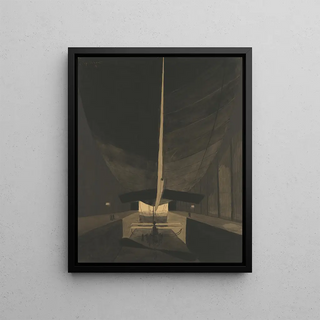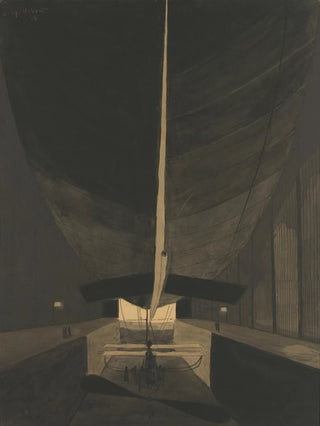Art print | The Belgium II airship in its hangar - Léon Spilliaert


View from behind

Frame (optional)
In the captivating universe of art, certain works stand out for their ability to capture a moment, an emotion, an atmosphere. "The Belgium II Airship in its Hangar" by Léon Spilliaert is undoubtedly one of these creations that, through its essence, transports us into a world both mysterious and fascinating. This artwork, painted in 1912, invites us to explore the depths of the human soul as well as the technological advances of its time. Depicting a majestic airship, Spilliaert prompts reflection on modernity, innovation, and the wonder faced with what was then considered a technical feat. The choice of the hangar as the setting emphasizes the contrast between the grandeur of the craft and the intimacy of its environment, creating an atmosphere that is both solemn and poetic.
Style and uniqueness of the work
Léon Spilliaert's style is distinguished by his bold use of light and shadow, as well as by his palette of often dark and mysterious colors. In "The Belgium II Airship in its Hangar," the artist plays with shades of blue and gray that evoke a melancholic, almost dreamlike ambiance. This artwork reflects a feeling of solitude and introspection, each brushstroke seeming to tell a story. The airship, although monumental, appears as a symbol of isolation, suspended in time, while the hangar, with its clean lines and geometric shapes, evokes the rigor of an era in full transformation. Spilliaert manages to create a dialogue between the subject and its environment, encouraging us to reflect on the place of man in relation to technology and nature.
The artist and his influence
Léon Spilliaert, an emblematic figure of Belgian symbolism, knew how to mark his era with a work rich in emotion and reflection. Born in 1881 in Ostend, he was influenced by the artistic currents of his time, while developing a personal style that is uniquely his own. His fascination with the sea, light, and urban landscapes is reflected in many creations, but it is his ability to express

Matte finish

View from behind

Frame (optional)
In the captivating universe of art, certain works stand out for their ability to capture a moment, an emotion, an atmosphere. "The Belgium II Airship in its Hangar" by Léon Spilliaert is undoubtedly one of these creations that, through its essence, transports us into a world both mysterious and fascinating. This artwork, painted in 1912, invites us to explore the depths of the human soul as well as the technological advances of its time. Depicting a majestic airship, Spilliaert prompts reflection on modernity, innovation, and the wonder faced with what was then considered a technical feat. The choice of the hangar as the setting emphasizes the contrast between the grandeur of the craft and the intimacy of its environment, creating an atmosphere that is both solemn and poetic.
Style and uniqueness of the work
Léon Spilliaert's style is distinguished by his bold use of light and shadow, as well as by his palette of often dark and mysterious colors. In "The Belgium II Airship in its Hangar," the artist plays with shades of blue and gray that evoke a melancholic, almost dreamlike ambiance. This artwork reflects a feeling of solitude and introspection, each brushstroke seeming to tell a story. The airship, although monumental, appears as a symbol of isolation, suspended in time, while the hangar, with its clean lines and geometric shapes, evokes the rigor of an era in full transformation. Spilliaert manages to create a dialogue between the subject and its environment, encouraging us to reflect on the place of man in relation to technology and nature.
The artist and his influence
Léon Spilliaert, an emblematic figure of Belgian symbolism, knew how to mark his era with a work rich in emotion and reflection. Born in 1881 in Ostend, he was influenced by the artistic currents of his time, while developing a personal style that is uniquely his own. His fascination with the sea, light, and urban landscapes is reflected in many creations, but it is his ability to express






